
Customer Effort Score (CES): How to Measure + Examples & Calculator
By Uttam Kumar Dash
January 16, 2023
Last Modified: November 13, 2025
Customer friction kills loyalty. The harder you make things, the faster people leave.
Customer Effort Score helps you spot where customers are struggling most. It’s a simple survey that measures how much work people put into basic tasks like making purchases or getting support.
Here’s how to use CES data to streamline your customer experience and keep people coming back.
If you already know the formula and just want a quick result, calculate your CES here:
Powered by Fluent Forms
What is Customer Effort Score? – CES meaning
Customer Effort Score (CES) measures how much effort customers expend to complete tasks with your business. It’s calculated using a simple survey question asking “How easy was it to [complete this task]?” with various rating scales.
CES identifies friction points in your customer journey. It measures the mental and physical energy customers spend during interactions such as making purchases, getting support, or using your product.
This helps you see where customers are putting in more effort than they should.
Traditional vs Modern CES Approach
1. Traditional Method
Back in 2010, Gartner introduced this method as part of its Customer Effort framework, based on research showing that reducing customer effort is a key driver of loyalty.
Still widely used in the customer service industry, this approach uses a 1-5 scale where 1 means “very easy” and 5 means “very difficult.” Your top 2 scores (1 and 2) count as positive responses, 3 as neutral, and 4-5 as negative.
2. Modern Approach
Reverses the traditional scale for a better user experience. Uses 1-5, 1-7 scales where 1 represents “extremely difficult” and higher numbers mean “extremely easy.” In a 1-5 scale, scores 4-5 are positive, 3 is neutral, and 1-2 are negative.
Here’s an example of a modern approach using a 1-7 scale survey measuring the Customer Effort Score.

Easy experiences give teams stronger customer success rates than high customer satisfaction scores. CES measures effort instead of feelings. This helps the team make data-driven decisions to reduce friction.
Customer Effort Score (CES) calculation
Now let’s learn how to do it from scratch. The calculation process of Customer Effort Score is pretty simple. Here’s how,
The Customer Effort Score (CES) formula:
CES = Sum of all customer effort scores ÷ Total number of responses
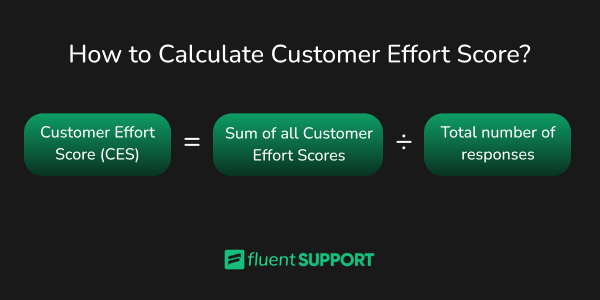
For example, If you surveyed 80 customers where 1 = extremely difficult and 5 = extremely easy:
- 25 customers rated 5 (extremely easy)
- 20 customers rated 4 (easy)
- 15 customers rated 3 (neutral)
- 12 customers rated 2 (difficult)
- 8 customers rated 1 (extremely difficult)
Sum of all scores: 25 fives: 5+5+5… (25 times) = 125 20 fours: 4+4+4… (20 times) = 80 15 threes: 3+3+3… (15 times) = 45 12 twos: 2+2+2… (12 times) = 24 8 ones: 1+1+1… (8 times) = 8
Total sum: 125 + 80 + 45 + 24 + 8 = 282
Calculation: 282 ÷ 80 = 3.5 CES
Note: If using 1 = very easy and 5 = very difficult, the same calculation gives 3.5 CES, but now lower scores are better (meaning less effort). Only the interpretation changes – the calculation stays identical.
Percentage-based CES calculation
For both traditional and modern approaches, higher percentages are always better. Use this formula to measure the overall customer satisfaction level.
CES Percentage Formula: Positive – Negative = CES Percentage
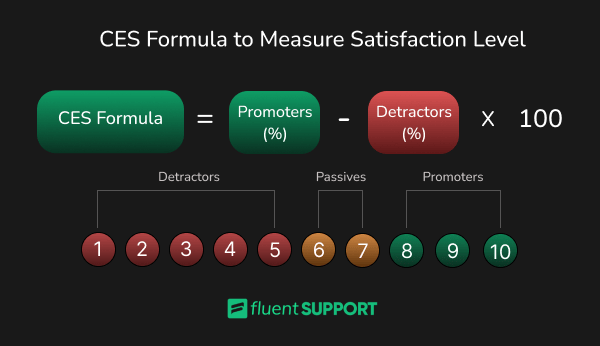
Example: 150 survey responses
- 90 positive responses (scores 4-5 in modern OR scores 1-2 in traditional)
- 35 negative responses (scores 1-2 in modern OR scores 4-5 in traditional)
- 25 neutral responses (score 3 in both)
Calculate percentages:
Positive: (90 ÷ 150) × 100 = 60%
Negative: (35 ÷ 150) × 100 = 23.33%
CES Percentage: 60% – 23.33% = 36.67%
Powered by Fluent Forms
Types of CES survey
When it comes to conducting a Customer Effort Score (CES) survey, there are different approaches you can take to gather feedback from your customers.
The type of scale you choose and the type of information you’re looking to gather will determine the structure of your survey. Here are the 4 most popular types of CES Surveys that we can see regularly.
1. Numbered scales
This type of survey is structured around a question that asks customers to rate the ease of use on a numbered scale. For example, “How easy was it to solve your problem today?”
Respondents are then asked to rank the ease of use on a scale of 1-7, with higher numbers indicating minimal effort and lower numbers indicating significant effort.
This type of scale can be confusing for some, so it’s recommended to color-code the scale from red to green for clarity.
2. Emoticon ratings
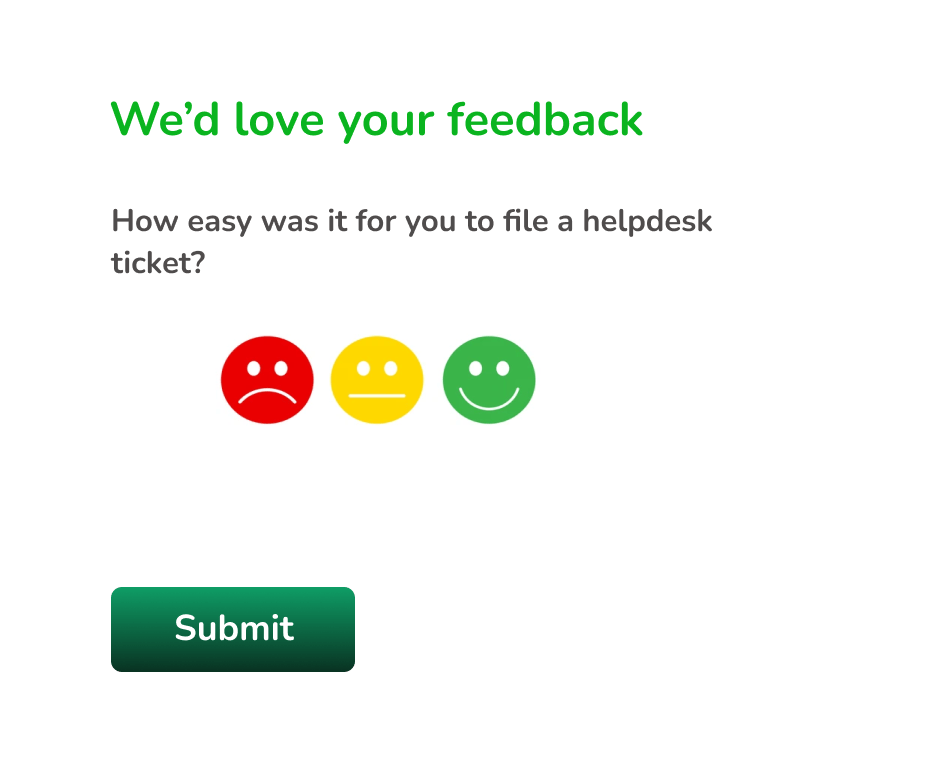
This type of survey is ideal for collecting feedback on minor aspects of your website or service. It’s easy to understand and takes only seconds to answer, increasing the likelihood of responses.
The question can be a simple one, such as “How easy was it to use our service?” or a statement such as “[Brand] made it easy to solve the issue,” and customers are asked to respond with an emoticon that best represents their feedback.
3. Likert scale
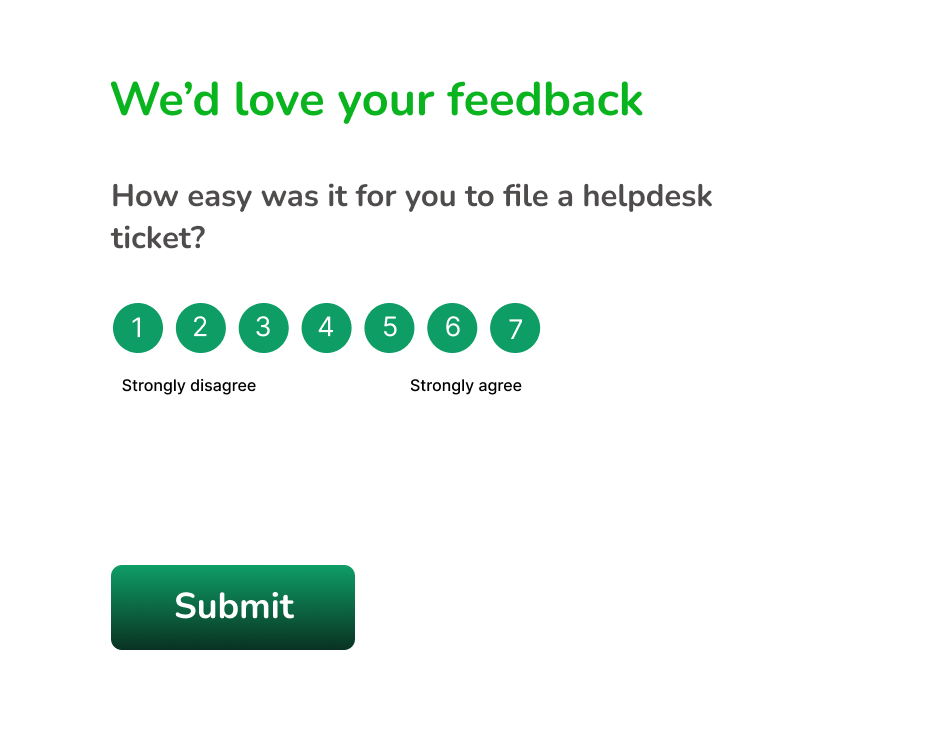
This type of survey is based on a Likert Scale, which is a psychometric scale used in research questionnaires. It’s a simple, non-question statement such as “The checkout process was easy to navigate.”
Users are asked to rate how much they agree or disagree with that statement on a 7-point scale, with options such as “strongly disagree” to “strongly agree.”
4. Thumbs up & down binary

This type of survey is a simple binary option, where customers are asked to rate their experience by giving a thumbs-up or thumbs-down.
It is a quick and easy way to collect customer feedback and can be used as a supplement to other types of CES surveys to get a more comprehensive understanding of customer experience.
Pro tip: Use a survey analytics dashboard to track CES, CSAT, NPS, and more in one place. This gives you real-time insights, helps you spot weak points, and adds valuable context to your customer feedback.
When to use Customer Effort Score (CES)
When it comes to using Customer Effort Score, timing is key. It’s important to send out a CES survey at the right moment to ensure that the information you’re collecting is relevant and accurate.
Here are a few key moments when using CES can be particularly valuable:
- Immediately after a purchase or subscription – Use CES to assess the smoothness of the buying process and identify any barriers.
- To compare with other metrics – Use CES alongside NPS or CSAT to see how effort impacts satisfaction and loyalty.
- To supplement product teams’ UI and UX testing – Gather CES scores after users interact with new designs or features to spot friction points early.
- Shortly after an interaction with customer service – Send CES right after a support session to measure how easy it was for customers to resolve their issues.
Pros and cons of CES surveys
Like any other data-gathering approach, utilizing CES surveys has its own set of benefits and drawbacks.
1. Pros of CES
- A strong predictor of future purchase behavior and referral likelihood.
- Highly specific and actionable, allowing for granular views of distinct areas of your business.
- Gives a clear view of areas that need improvement.
- Easy to implement.
2. Cons of CES
- Does not provide information on the customer’s overall relationship or satisfaction with your business.
- Lack of customer segmentation by customer type or buyer journey.
- It only measures specific experiences, rather than the overall effort required to interact with your business.
- Surveys must be sent immediately after customers have the experience to avoid inaccurate results.
10 common CES questions (Examples)
The image below shows some of the most common questions that are frequently asked in CES surveys.
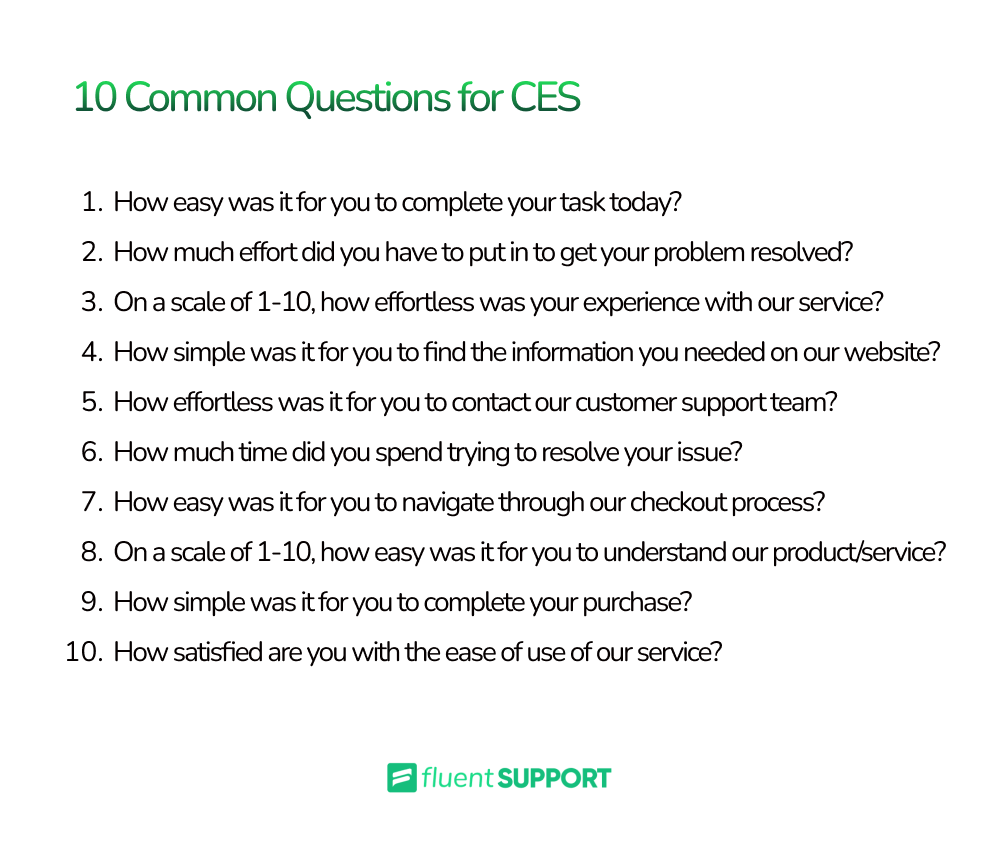
How CES compares to NPS and CSAT
The CES measures how simple or complex customer interactions with your company are. It’s a valuable indicator for figuring out how your company compares to the competition in terms of user experience.
However, it doesn’t provide a complete picture of consumer satisfaction. Customer Satisfaction (CSAT) and Net Promoter Score (NPS) are relevant metrics in this context.
While CSAT measures immediate satisfaction with a good or service, NPS measures overall consumer happiness and loyalty. You may acquire a more comprehensive understanding of client experience and satisfaction by combining these indicators.
It’s vital to keep in mind that NPS and CSAT have their own limits and should be used in conjunction with follow-up questions to elicit more information.
Final Verdict
Customer Effort Score (CES) shows how easy it is for customers to deal with your business. Use it to spot problem areas, but pair it with CSAT and NPS for a full view of customer experience. Track all three to make smarter decisions and boost loyalty over time.












Leave a Reply